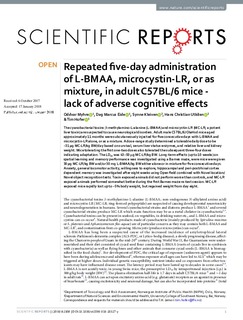Repeated five-day administration of L-BMAA, microcystin-LR, or as mixture, in adult C57BL/6 mice - lack of adverse cognitive effects
Journal article, Peer reviewed
Published version
Permanent lenke
http://hdl.handle.net/11250/2582519Utgivelsesdato
2018Metadata
Vis full innførselSamlinger
Sammendrag
The cyanobacterial toxins β-methylamino-L-alanine (L-BMAA) and microcystin-LR (MC-LR; a potent liver toxin) are suspected to cause neurological disorders. Adult male C57BL/6JOlaHsd mice aged approximately 11 months were subcutaneously injected for five consecutive days with L-BMAA and microcystin-LR alone, or as a mixture. A dose-range study determined a tolerable daily dose to be ~31 µg MC-LR/kg BW/day based on survival, serum liver status enzymes, and relative liver and kidney weight. Mice tolerating the first one-two doses also tolerated the subsequent three-four doses indicating adaptation. The LD50 was 43–50 μg MC-LR/kg BW. Long-term effects (up to 10 weeks) on spatial learning and memory performance was investigated using a Barnes maze, were mice were given 30 µg MC-LR/kg BW and/or 30 mg L-BMAA/kg BW either alone or in mixture for five consecutive days. Anxiety, general locomotor activity, willingness to explore, hippocampal and peri-postrhinal cortex dependent memory was investigated after eight weeks using Open field combined with Novel location/Novel object recognition tests. Toxin exposed animals did not perform worse than controls, and MC-LR exposed animals performed somewhat better during the first Barnes maze re-test session. MC-LR exposed mice rapidly lost up to ~5% body weight, but regained weight from day eight.
Beskrivelse
Open Access This article is licensed under a Creative Commons Attribution 4.0 International License, which permits use, sharing, adaptation, distribution and reproduction in any medium or format, as long as you give appropriate credit to the original author(s) and the source, provide a link to the Creative Commons license, and indicate if changes were made. The images or other third party material in this article are included in the article’s Creative Commons license, unless indicated otherwise in a credit line to the material. If material is not included in the article’s Creative Commons license and your intended use is not permitted by statutory regulation or exceeds the permitted use, you will need to obtain permission directly from the copyright holder.

